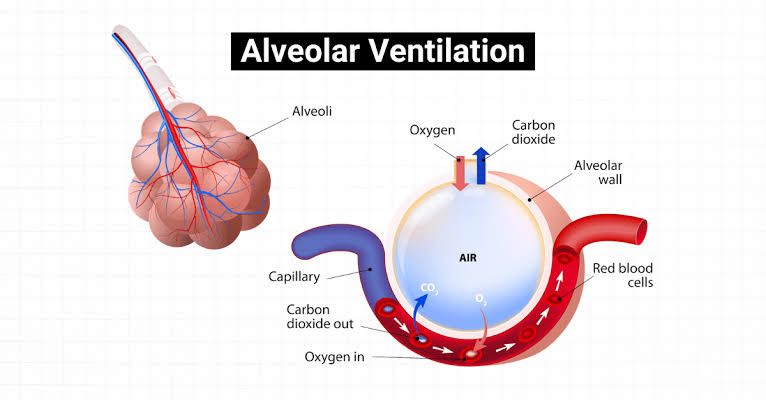
Definition of Alveolar Ventilation
Alveolar ventilation refers to the volume of air that enters and leaves the alveoli per minute, which is available for gas exchange with the blood. It excludes the air that remains in the anatomic dead space, where no gas exchange occurs. The formula for alveolar ventilation can be expressed as:
(VA) = (VT) – (VD)
Where:
- VA = Alveolar ventilation per breath
- VT = Tidal volume (total volume of air inhaled or exhaled per breath)
- VD = Dead space volume (volume of air in the conducting airways where no gas exchange occurs).
Factors That Determine Alveolar Ventilation
Several factors influence alveolar ventilation:
- Tidal Volume (VT): This is the total amount of air inhaled or exhaled during a single breath. A higher tidal volume increases alveolar ventilation if dead space remains constant.
- Dead Space Volume (VD):
- Includes both anatomic and physiologic dead spaces.
- An increase in dead space reduces alveolar ventilation for a given tidal volume.
- Respiratory Rate (f): The number of breaths taken per minute also affects alveolar ventilation. Faster breathing rates can increase overall ventilation but may reduce efficiency if shallow breaths predominate.
- Body Position: Changes in body position can alter lung mechanics and regional distribution of ventilation, affecting how much fresh air reaches the alveoli.
- Lung Compliance and Airway Resistance: Conditions like emphysema or asthma can reduce effective alveolar ventilation by altering lung compliance or increasing airway resistance.
- Gas Exchange Efficiency: Factors such as perfusion mismatch or diseases that impair diffusion capacity can indirectly affect how much oxygen and carbon dioxide are exchanged at the alveoli.
Differences Between Anatomic and Physiologic Dead Spaces
1. Anatomic Dead Space:
- Refers to the portion of the respiratory system where no gas exchange occurs, such as the trachea, bronchi, and other conducting airways.
- Typically about 1 mL per pound of body weight in a healthy adult (e.g., ~150 mL for a 150-pound individual).
- Measured using Fowler’s method, which monitors nitrogen concentration after a single breath of pure oxygen.
2. Physiologic Dead Space:
- Includes both anatomic dead space and any additional “alveolar dead space.”
- Alveolar dead space refers to ventilated alveoli that are not perfused with blood; thus, no gas exchange occurs there.
- In healthy individuals, physiologic dead space equals anatomic dead space because there is minimal alveolar dead space.
- Calculated using the Bohr equation based on arterial PCO2 and mixed expired PCO2 levels: (VD/VT) = (PaCO2 − PECO2) / (PaCO2)
Where:- VD/VT = Ratio of dead space to tidal volume
- PaCO2 = Arterial partial pressure of CO2
- PECO2 = Partial pressure of CO2 in expired air.
Effect of Dead Space on Alveolar Ventilation
Dead space significantly impacts alveolar ventilation because it represents wasted ventilation—air that does not participate in gas exchange:
- If tidal volume remains constant but dead space increases (e.g., due to disease or mechanical devices like ventilator tubing), less fresh air reaches the alveoli.
- For example: If VT = 500 mL and VD = 150 mL, then VA = 350 mL per breath. However, if VD increases to 200 mL (e.g., due to increased physiologic dead space), VA decreases to only 300 mL per breath.
- This reduction in effective ventilation can lead to hypoventilation, hypercapnia (increased arterial PCO2), and reduced oxygenation.
Rate of Alveolar Ventilation
The rate of alveolar ventilation is calculated as:
(VA) = (f) × [(VT) − (VD)]
Where:
- VA = Total alveolar ventilation per minute
- f = Respiratory rate (breaths/minute)
- VT = Tidal volume
- VD = Dead space volume
For example:
If f = 12 breaths/minute, VT = 500 mL/breath, and VD = 150 mL/breath:
(VA) = 12 × (500 − 150)
(VA) = 12 × 350
(VA) = 4200 mL/min or 4.2 L/min.
Effects of Alveolar Ventilation on PCO2 and PO2
Effects on PCO2:
- Alveolar partial pressure of CO2 (PACO2) is inversely proportional to alveolar ventilation when carbon dioxide production remains constant: (PACO2 ∝ V̇CO₂ / VA)
If VA doubles while CO₂ production stays constant, PACO₂ decreases by half.
Conversely, if VA is halved, PACO₂ doubles.
Effects on PO2:
- Increasing alveolar ventilation raises partial pressure of oxygen in the alveoli (PAO₂), but this effect has limits:
- At sea level breathing room air (~21% O₂), PAO₂ cannot exceed ~149 mmHg because this is determined by inspired oxygen tension ([PIO₂]) minus water vapor pressure ([PH₂O]) at body temperature.
- Doubling VA improves PAO₂ only up to this limit unless supplemental oxygen is provided.
In summary:
- Increased VA lowers PACO₂ while raising PAO₂ within physiological limits.
- Decreased VA leads to hypercapnia (high PACO₂) and hypoxemia (low PAO₂).







